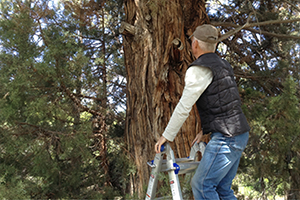
I once described trapping out as a not-so-satisfactory way of removing a colony of bees from an enclosed structure or tree. Trapping requires much beekeeper input during a multi-step process. Even when things go well, a trap-out can leave a dead queen and her brood to decay, and may allow untended honey stores to ferment and drip inside walls, attracting vermin and making a horrendous mess. So why bother?
No matter how cumbersome it may be, sometimes a trap-out is the best answer to an otherwise sticky situation. If the colony is disturbing the public, frightening passersby, or intimidating children and service providers, the colony may need to be removed. But simply killing the colony may be unacceptable to the property owners, and leaving a nest inside a building or tree may attract another swarm.
A Better Bee Trap
Several years ago, Naomi and Larry Price of Prineville, Oregon began doing trap-outs as a public service. Before beginning, they studied many different methods, outlining the pros and cons of each system. After much conjecture, they decided to use the Hogan Bee Trap as a model, but made various modifications in order to make the process more bee friendly.
When all goes according to plan, the entire colony — including the queen — will move into a new “section” of their nesting space, the one the beekeeper provides. The brood will all emerge and most, if not all, of the honey stores will be depleted from the old combs. In addition, the beekeeper will have a new queenright colony, ready to move to a new location.
Does it always work? Unfortunately, no. After trapping for a number of years, Naomi is convinced that not all colonies can be saved. She says it’s important to remember that no two colonies and no two locations are exactly alike. You need to be ready to alter any piece of equipment and any part of the procedure each time you set up a new trap.
Removing Instead of Harvesting
Naomi stresses that the original trap-out was designed for harvesting bees rather than removing the entire colony from its home. In a standard trap-out, the workers and drones are captured as they leave the hive, and little effort is made to recover the queen. In the end, bees frequently starve because no food or water is coming in. In response, young nurse bees are forced to leave the nest to begin premature foraging.
Since the standard system allows no returning foragers to access the nest, the job of removal is only partially completed, even after several weeks. Often, dead or dying bees and brood remain in the space after the beekeeper is finished, leaving an unpleasant mess for the homeowner.
With their revised system, Naomi and Larry are able to achieve the dual goals of removing the entire colony from its cavity, while keeping the bees healthy and the colony intact, queen and all. Success requires an understanding of honey bee biology and behavior. Using that knowledge, the beekeeper can minimize removal stress by selecting the best time to begin the trap-out, and can incorporate processes that use the bees’ instinctive behavior rather than brute force.
By timing the trap-out to coincide with swarm season, the beekeeper can take advantage of the colony’s biological imperative to reproduce, nest, and raise brood. Instead of working against the bees’ instinct, you work with it, making the process less damaging to the bees.
The removal of the colony can be divided into four phases. The amount of time required for each phase will depend on the individual situation.
Phase I: Seal All Extra Entrances
Wild colonies often have more than one nest entrance, but those openings may not be obvious, especially at first. It pays to spend time watching the bees come and go to see if you can detect any alternate routes into the nesting cavity. Once you find the entrances, select one that is easy to reach to be the main entrance. If it is a long narrow entrance, reduce it to about 1 or 2 inches.
The next step is crucial: all additional access points must be sealed and darkened. Construction grade plastic garbage bags can be layered around the tree or structure, then ….


